Your Guide to Tunisian Crochet and Afghan Stitch: Patterns, Stitches, Tutorials, Photos, Tips, Ideas and More
Are you interested in learning about Tunisian crochet? This page will get you started with Tunisian crochet plus introduce you to bunches of free Tunisian crochet stitch tutorials, free Tunisian crochet patterns, and suggestions for excellent Tunisian crochet pattern books you’ll want to know about.
Perhaps you just want to take a peek at some info to satisfy your curiosity about Tunisian crochet — or perhaps you want to master the technique completely. Either way, you’ll find enough Tunisian crochet stitch tutorials, instructions, patterns, project ideas, techniques and links to keep you busy for hours / days / weeks / months, depending on how much time you want to devote to it. So let’s get started!
What Is Tunisian Crochet?
Tunisian crochet is a crochet technique in which crafters utilize long, smooth crochet hooks along with yarn, crochet thread or other fiber to create fabrics or finished projects. There are many similarities between Tunisian crochet and knitting, but structurally, the resulting fabric is crocheted — even though in some cases it looks similar in appearance to knitting or weaving.
Tunisian Crochet Supplies
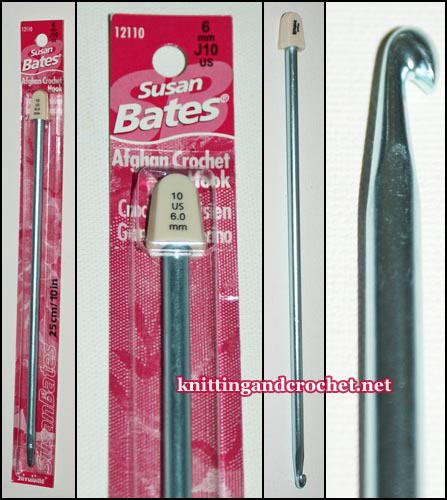
Like traditional crochet, Tunisian crochet is a low-tech pastime which doesn’t require a significant upfront investment in supplies. You’ll need a long Tunisian crochet hook, which is also known as an “afghan hook,” plus some yarn, crochet thread or alternative material.
Yarn is the currently the most popular material being utilized for Tunisian crochet, but there’s no good reason why you couldn’t try this technique with other materials like plarn, string, twine, fabric strips etc.
I’ve even tried tunisian crochet with wire and beads — which was challenging, but doable for a small piece. I made a bracelet. If that sounds interesting to you, be sure to check out the jewelry section below to grab the free crochet pattern.
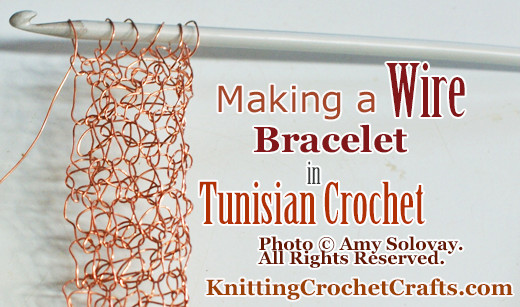
How to Hold a Tunisian Crochet Hook
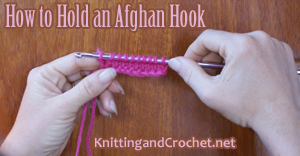
You’ll want to hold a Tunisian crochet hook in your dominant hand. However, you’ll probably need to use both your hands for manipulating the work-in-progress and for moving stitches along the hook in one direction or the other as you crochet.
Because the Tunisian crochet hook needs to be able to rotate and move freely inside your hand as you are working, it’s best to use a not-too-tight overhand grip. This allows you to manipulate both the hook and the work as you crochet; use a gentle touch and avoid “death gripping” the hook.
If you’re already familiar with traditional crochet, you might be aware that there are two basic types of grips — the pencil grip and the knife grip. The pencil grip is not ideal for using with Tunisian crochet, so you’ll want to get comfortable with the knife grip.
How to Do Tunisian Crochet: Tunisian Crochet Stitches, Instructions and Tutorials
The Basic Tunisian Crochet Stitch Is Called “Afghan Stitch” But Has Other Names, Too.
You can also call it “Tunisian Simple Stitch.” In vintage crochet manuals, I’ve seen people refer to it as “Idiot Stitch,” but I think that’s just harsh. Yikes. I wouldn’t recommend calling it that, personally.
Tunisian Knit Stitch
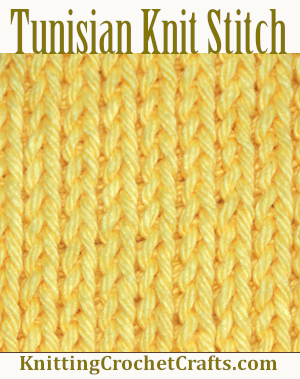
At first glance, Tunisian knit stitch looks much like knitted stockinette stitch (or stocking stitch, if you use British English terminology).
However, Tunisian knit stitch doesn’t perform like stockinette stitch does. It typically turns out bulkier and less stretchy.
If what you want is knitted fabric, this isn’t it. That said, I think this stitch is fascinating and fun, and I’ve used it to crochet bunches of different projects.
This Tunisian Knit Dishcloth is a fantastic, free starter pattern for learning and practicing the Tunisian knit stitch.
You might also want to try this versatile, casual Tunisian knit stitch headband pattern.

Tunisian Crochet Lace Stitches
Tunisian Crochet Mesh Stitch
I apologize that this free tutorial is currently a hot mess. I’m working on it.
Tunisian Crochet Woven Stitch
How to Make Your Crochet Look Like Weaving
There are mind-boggling numbers of different ways to make your crochet look like weaving.
Afghan stitch looks just like weaving if you use this simple trick:
- Choose 2 contrasting colors, A and B.
- Work your starting chain and your forward pass in color A.
- Work your return pass and the next forward pass in color B.
- Work your next return pass and your next forward pass in color A.
- Work your next return pass and your next forward pass in color B.
- Continue alternating colors in this way until the piece is the desired size.
- Do not cut your colors in between passes; just drop the color when you’re finished with it and pick it up again when you’re ready to resume working with it.
Woven Crochet + Tunisian Crochet
Woven crochet is a vintage technique which combines elements from both crochet and weaving. To create a fabric like this, you would take a crocheted piece and integrate yarn, thread, fiber or material into it by weaving the material into the fabric in some way. Usually, this is done by creating a mesh fabric or lace fabric and then weaving the material into the open areas. If you want to create plaid designs in crochet, this is one possible way to do it — because you can do your weaving in the vertical direction, while easily making stripes with your crochet stitches in the horizontal direction.
All of this can be done with either traditional crochet, or with Tunisian crochet. While it is more common to see woven crochet examples created with filet crochet-like mesh fabrics, there are many interesting possibilities for creating woven crochet projects using Tunisian crochet as your base fabric. Try using the Tunisian crochet mesh stitch as your mesh and weaving long crochet chains or lengths of ribbon into your piece.
See Also: Tunisian Crochet Stitches
Shaping Tunisian Crochet
You can increase and decrease in afghan stitch to add shaping to your projects. Find free instructions at the following links:
Tunisian Crochet Books
Fair Isle Tunisian Crochet — This unique book focuses entirely on giving you instructions for how to do the Fair Isle Tunisian crochet technique. You also get a whole bunch of gorgeous patterns for making blankets, sweaters, cowls, fingerless gloves and other projects using this technique.
Learn Tunisian Crochet With a Double-Ended Hook: 101 Double-Ended Hook Stitches: a Crochet Stitch Dictionary
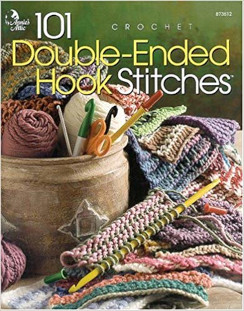
Click here to see more of my picks for the best Tunisian crochet books.
More Tunisian Crochet Patterns
Tunisian Crochet Potholders
Easy Afghan Stitch Potholders
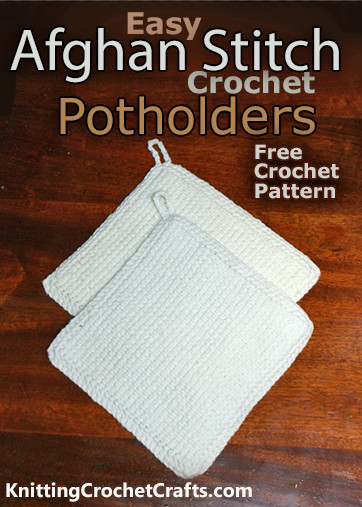
Color Mix Afghan Stitch Crochet Potholders: Free Pattern
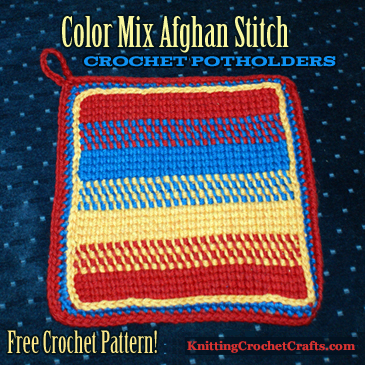
Pretty Afghan Stitch Potholders
I apologize that this pattern is currently a hot mess. I’m working on it.
Tunisian Crochet Jewelry Patterns
Afghan Stitch Bracelet in Wire Crochet
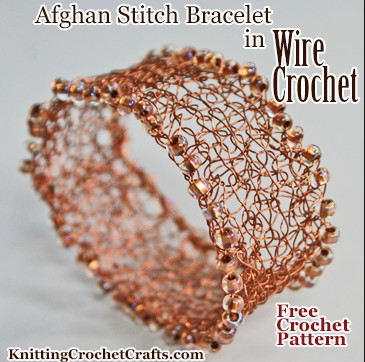
Tunisian Crochet Tips
Tip #1: When shopping for a Tunisian crochet hook, buy a larger hook than you would usually use for working a traditional crochet project. For example, if you would usually use an I hook with worsted weight yarn, grab a J hook for your Tunisian crochet with worsted weight yarn. As with any crochet project, you may wish to try working a swatch with the hook and yarn you are planning to use before committing to crochet the whole project.
Tip #2: Do not be alarmed if your Tunisian crochet pieces curl up. This is totally normal, just as it is when knitted stockinette stitch curls up. There are various things you can do to discourage your piece from curling. Like with knitting, you can combine the stitch with others that do not curl. The curl might also go away when you finish your project — for example, if you sew two afghan stitch pieces wrong sides together to make a potholder, the finished potholder won’t curl.
Tunisian Crochet Designers
- Amy Solovay is your hostess here at knittingcrochetcrafts.com. She enjoys designing and making Tunisian crochet projects as well as projects made using other crochet techniques.
- Sharon Silverman is a prolific designer whose technique of choice is often Tunisian crochet. She has written multiple books on the topic, including Tunisian Crochet for Baby and Tunisian Crochet Baby Blankets.
- Are you a Tunisian crochet designer? Would you like to have your work featured here on this page? Contact me!
Hopefully this gives you enough information to get started with Tunisian crochet, find interesting Tunisian crochet stitch tutorials, and load up on fantastic Tunisian crochet patterns. If you haven’t already learned Tunisian crochet, I hope you’ll give the technique a try — and that you’ll enjoy it!
Please Visit My Ko-Fi Shop HERE to Find My Sample Sale, Destash Sale and Digital PDF Pattern Downloads for Sale.
By Amy Solovay
About the Author: Amy Solovay is a real person; she is NOT a robot and does not use artificial intelligence (AI) to write articles for this website. She is a real, live, human content creator and educator who holds a bachelor’s degree with a studio art minor; she has also earned a separate degree in textile design. Amy learned to crochet as a small child, and she still enjoys crocheting all these years later. Beyond that, she enjoys introducing other crafters to the best new craft supplies, and she also loves helping crafters learn new techniques for making the most of the craft supplies they buy.
As an educator, Amy Solovay used to teach in-person college courses in trend forecasting, marketing and surface design at California Design College in Los Angeles.
Nowadays, Amy uses online platforms to teach digital courses to craft pattern designers, content creators and influencers all over the world.
Thanks for visiting!
This page was last updated on 10-15-2025.
